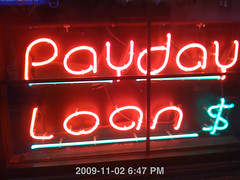- RT @mymoneyshrugged: The government breaks your leg, and hands you a crutch saying "see without me, you couldn't walk." #
- @bargainr What weeks do you need a FoF host for? in reply to bargainr #
- Awesome tagline: The coolest you'll look pooping your pants. Yay, @Huggies! #
- A textbook is not the real world. Not all business management professors understand marketing. #
- RT @thegoodhuman: Walden on work "spending best part of one's life earning money in order to enjoy (cont) http://tl.gd/2gugo6 #
The Magic Toilet

- Image by tokyofortwo via Flickr
My toilet is saving me $1200.
For a long time, my toilet ran. It was a nearly steady stream of money slipping down the drain. I knew that replacing the flapper was a quick job, but it was easy to ignore. If I wasn’t in the bathroom, I couldn’t hear it. If I was in the bathroom, I was otherwise occupied.
When I finally got sick of it, I started researching how to fix a running toilet because I had never done it before. I found the HydroRight Dual-Flush Converter. It’s the magical push-button, two-stage flusher. Yes, science fiction has taken over my bathroom. Or at least my toilet.
I bought the dual-flush converter, which replaces the flusher and the flapper. It has two buttons, which each use different amounts of water, depending on what you need it to do. I’m sure there’s a poop joke in there somewhere, but I’m pretending to have too much class to make it.
I also bought the matching fill valve. This lets you set how much water is allowed into the tank much better than just putting a brick in the tank. It’s a much faster fill and has a pressure nozzle that lies on the bottom of the tank. Every time you flush, it cleans the inside of the tank. Before I put it in, it had been at least 5 years since I had opened the tank. It was black. Two weeks later, it was white again. I wouldn’t want to eat off of it, or drink the water, but it was a definite improvement.
Installation would have been easier if the calcium buildup hadn’t welded the flush handle to the tank. That’s what reciprocating saws are for, though. That, and scaring my wife with the idea of replacing the toilet. Once the handle was off, it took 15 minutes to install.
“Wow”, you say? “Where’s the $1200”, you say? We’ve had this setup, which cost $35.42, since June 8th, 2010. It’s now September. That’s summer. We’ve watered both the lawn and the garden and our quarterly water bill has gone down $30, almost paying for the poo-gadget already. $30 X 4 = $120 per year, or $1200 over 10 years.
Yes, it will take a decade, but my toilet is saving me $1200.
The Evils of a Reverse Mortgage
Picture it: Sicily, 1922.
Sorry, wrong channel. Let’s try again.
Picture it: 20, 30, 50 years from now. You’re old. The money you’ve been failing to save so you could stock up on Fritos and obsolete video game consoles(to survive the zombie apocalypse in style) would come in handy about now, since the end of the world never happened. Note to self: Never trust an ancient Mayan.
You’re 70, with no savings and no income aside from the Social Security check that hasn’t been adjusted for inflation since the Palin(Bristol) administration.
But you own your house and that nice young man down at Yersk Rude Bank recommended a reverse mortgage. That could give you all of the money you need to live a comfortable retirement and pay for a bit of a funeral.
Right?
Nazzofast.
Of all of the possible social security strategies, this is one of the worst.
What is a reverse mortgage?
In a traditional mortgage, you’re given a chunk of money guaranteed by your home. You have to pay that money back over time, or you’ll lose your house. In a reverse mortgage, you’re still converting your home’s equity into cash, but you don’t have to pay it back until you die or move, including moving into a nursing home. You are effectively abandoning future-house in exchange for now-money.
Who qualifies for a reverse mortgage?
If you are 62 or older, and live in a home you own, you qualify. Credit and income are not considered.
Why would you want a reverse mortgage?
If money is tight and you have no prospects, a reverse mortgage may be a valid consideration. A better consideration would be to take out a traditional loan and make monthly payments out of that lump sum, or sell your house outright and move someplace more affordable.
What are the downsides of a reverse mortgage?
You lose your house. Technically, your heirs lose your house. A reverse mortgage becomes due when you die. If your heirs can’t cover the loan, the house will be foreclosed. Also, this is a loan. It accumulates interest, even if you aren’t paying it back. If you borrow $200,000 and die in 10 years, your estate may owe $400,000 on the reverse mortgage. If this is a treasured family home, losing it could come as a shocking blow at a time when your family would already be reeling from the loss of, well, you.
What if you really don’t like your heirs?
I’d still recommend getting a traditional mortgage. You can throw a killer party and then, you’ll rebuild equity over time. That way, if you live longer than you expect, you can refinance and throw another killer party. If you go this route, don’t invite the kids, but be sure to hire a videographer so they can see how you’re spending their inheritance.
I’m not a banker or a financial advisor, but I’d recommend against a reverse mortgage in almost all circumstances.
How about you? Would you get one, or recommend one? What’s your preferred method to hurt your ungrateful heirs?
The Unfrugal Meal
I spend a lot of time talking about how to save money here. It’s kind of what I do.
Not today.
Today, I’m going to talk about the best way I’ve wasted money during my vacation this week.
First, so my feelings are completely understood: A vacation is about experiences and memories. I could spend all day at the park with my kids, or I could spend a memorable meal with them. Which will they remember longer?
It ain’t the park. They are there almost every day.
Of course, if the restaurant is McDonald’s they wouldn’t remember for long, either.
Tuesday, after a long day of hands-on, interactive museum-going, we took the kids to a Japanese steakhouse. Teppanyaki, where they cook the food at the table, complete with fire, spatula spinning, and airborne food.
I’m the only one in my family who has seen that before. Honestly, watching the art, the skill, the banter, and the giant fireball leaves me as wide-eyed as my kids.
They loved it.
Watching the chef throw a bowl full of rice across the table made my son’s jaw drop.
Seeing the chef carry fire from one side of the grill to the other on his fingers made my youngest squeal and beg for more fire tricks.
Getting squirted by the chef when he was putting out a flare-up made the middle brat giggle, possibly because the squirt gun was a little kid, dressed up as a fireman, with his pants down. She got “peed” on and loved it.
Aside from cooking-as-a-show, the service was fantastic. There was always a waiter nearby to keep our water glasses full or to provide “little kid” chopsticks, which are modified with rubber band to remove the need for skill to eat. They had the courses perfectly timed. The minute the salad was cleared, the soup was delivered. When that was done, the chef rolled up to start on the rice. My two-year-old was eating white rice without complaint for the first time.
Giggles and squeals. Three days later, they are still talking about it. My 11-year-old, who’s trying so hard to be an unimpressible teenager, says it was the coolest restaurant he’s ever seen.
Frugal, it wasn’t, but the memories were worth the money.
Why I Hate Payday Loans
I hate payday loans and payday lenders.
The way a way a payday loan works is that you go into a payday lender and you sign a check for the amount you want to borrow, plus their fee. They give you money that you don’t have to pay back until payday. It’s generally a two-week loan.
Now, this two week loan comes with a fee, so if you want to borrow $100, they’ll charge you a $25 fee, plus a percent of the total loan, so for that $100 loan, you’ll have to pay back $128.28.
That’s only 28% of actual interest; that’s not terrible. However, if you prorate that to figure the APR, which is what everyone means when they say “I’ve got a 7% interest rate”, it comes out to 737%. That’s nuts.
They are a very bad financial plan.
Those loans may save you from an overdraft fee, but they’ll cost almost as much as an overdraft fee, and the way they are rigged–with high fees, due on payday–you’re more likely to need another one soon. They are structured to keep you from ever getting out from under the payday loan cycle.
For those reasons, I consider payday loan companies to be slimy. Look at any of their sites. Almost none are upfront about the total cost of the loan.
So I don’t take their ads. When an advertiser contacts me, my rate sheet says very clealy that I will not take payday loan ads. The reason for that is–in my mind–when I accept an advertiser, I am–in some form–endorsing that company, or at least, I am agreeing that they are a legitimate business and I am helping them conduct that business.
In all of the time I’ve been taking ads, I’ve made exactly one exception to that rule. On the front page of that advertiser’s website, they had the prorated APR in bright, bold red letters. It was still a really bad deal, but with that level of disclosure, I felt comfortable that nobody would click through and sign up without knowing what they were getting into. That was a payday lender with integrity, as oxymoronic as that sounds.
Time vs Money Redux
Saving money is a good thing
Saving time is a good thing.
Somewhere in between, there has to be a balance. It’s possible to spend far too much time to save very little money.
For example, on September 30th, I left for the Financial Blogger’s Conference. Thinking I’d be frugal and save a little money, I told my GPS to avoid the toll roads. According to Google maps, the cheap route should have added 20 minutes to my trip. Coming into Illinois from Wisconsin on the toll roads, it’s easy to spend that much time waiting to pay the toll, since I don’t own an Illinois magic toll-paying box.
Unfortunately, the little smart-a** suction-cupped to my windshield sent mebthrough every construction zone between Wisconsin and Schaumberg, Illinois.
That sucks.
I went through a series of little towns with speed limits that randomly changed from block to block. Road construction had half of the roads down to just one lane. All told, I saved $3.40, judging by the tolls heading home, but the horrible detour cost me well over an hour and a half of time.
I saved $3.40, but lost 90 minutes. That’s not a good return on investment.
Just a month ago, I was ripping into my mother-in-law for wasting half an hour to save 75 cents. Then I have to go and demonstrate how horrible I am at making that save time vs money judgement.
I need to work on that.
What’s the most time you’ve spent to save a small amount of money?






